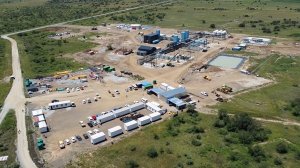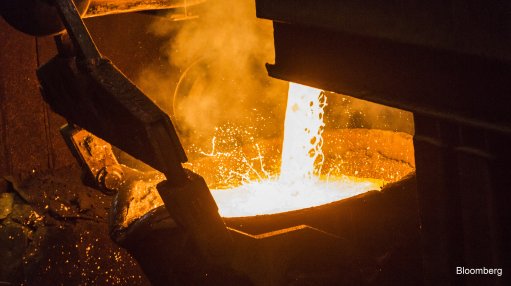Virginia gas project Phase 1 reaches completion



VIRGINIA GAS FIELDS Phase 1 based in the Free State reaches completion
STEFANO MARANI Renergen’s total capital expenditure is about 15%, the company had to manoeuvre around Covid-19 price escalations
Helium and domestic natural gas producer Renergen completed the development of Phase 1 of its Virginia Gas Project in July and has started with commercial operation.
The project comprises the development of 52 km of gas assemblage pipeline and cryogenic liquefaction processing facilities located across Welkom, Virginia and Theunissen, in the Free State.
To date, project costs have amounted to R1-billion, which are within the original budget.
In terms of overall project overruns, Renergen’s total capital expenditure is about 15%, the company had to manoeuvre around Covid-19 price escalations, states Renergen CEO Stefano Marani.
The shortage of semiconductors and microchips also presented a challenge, as it led to a delay in the delivery of many critical systems that were required during the project’s construction. As a result, construction was delayed by six months, which resulted in further challenges.
However, Renergen successfully mitigated all challenges, he adds.
Phase 1 intends to cultivate 350 kg of helium and 50 t of liquified natural gas (LNG), while Phase 2 aims to produce about 5 t/d of helium an estimated 700 t/d of LNG.
Marani explains that the combined production from Phase 1 and Phase 2 will use only 90% of the proven reserves, or 1P, – which comprise one-third of the total proven reserves or 3P – from the start of production at the plant to 2042, when the licence expires.
Further, the helium market is out of balance between supply and demand, with demand for helium growing substantially while supply has been curtailed, owing to some larger helium plants failing to start up, and smaller plants being offline or struggling to regain activity.
Therefore, Marani expects that the Virginia Gas project, specifically Phase 2, will help meet the demand for helium.
“We see our project as a critical factor at this specific time, when most plants are offline. There is also a demand for increased diversification in the geographical landscape of where helium is sourced from,” he elaborates.
Decarbonisation
Owing to trends across the helium and LNG industry that aim to align with moving towards decarbonisation, more renewable-energy Style technologies are being pursued.
However, the production of renewable energy equipment often uses non-renewable energy sources, such as oil, coal and natural gas, which will contribute to carbon emissions, Marani explains.
Further, an increase in the price of non-renewable energy sources results in increased production costs of renewable energy technologies.
Natural gas presents a particular opportunity to significantly decarbonise the current state of energy production, as gas is substantially easier to work with and relatively inexpensive. This can assist in transitioning to renewable energy and with decarbonisation efforts.
Marani adds that an increasingly important measure of how we use energy is Energy Return on Energy Invested (ERORI). Coal is highest at close to 130, with natural gas around 70 units returned for every unit invested in producing it. Renewables are significantly lower, which may ultimately lead to energy insecurity in the short to medium term.
Compared to coal, natural gas produces less greenhouse gas emissions, along with fewer carcinogenic particles, which is associated with health benefits.
“If South Africa had to produce electricity from natural gas, compared with using B grade and C grade coal, there would be a decrease of between a 60% and 70% in equivalent greenhouse gas emissions,” he points out.
Marani concludes that although the project is one of the larger helium projects globally, Renergen is also excited about its upcoming projects, which will be announced in the coming months.
Comments
Press Office
Announcements
What's On
Subscribe to improve your user experience...
Option 1 (equivalent of R125 a month):
Receive a weekly copy of Creamer Media's Engineering News & Mining Weekly magazine
(print copy for those in South Africa and e-magazine for those outside of South Africa)
Receive daily email newsletters
Access to full search results
Access archive of magazine back copies
Access to Projects in Progress
Access to ONE Research Report of your choice in PDF format
Option 2 (equivalent of R375 a month):
All benefits from Option 1
PLUS
Access to Creamer Media's Research Channel Africa for ALL Research Reports, in PDF format, on various industrial and mining sectors
including Electricity; Water; Energy Transition; Hydrogen; Roads, Rail and Ports; Coal; Gold; Platinum; Battery Metals; etc.
Already a subscriber?
Forgotten your password?
Receive weekly copy of Creamer Media's Engineering News & Mining Weekly magazine (print copy for those in South Africa and e-magazine for those outside of South Africa)
➕
Recieve daily email newsletters
➕
Access to full search results
➕
Access archive of magazine back copies
➕
Access to Projects in Progress
➕
Access to ONE Research Report of your choice in PDF format
RESEARCH CHANNEL AFRICA
R4500 (equivalent of R375 a month)
SUBSCRIBEAll benefits from Option 1
➕
Access to Creamer Media's Research Channel Africa for ALL Research Reports on various industrial and mining sectors, in PDF format, including on:
Electricity
➕
Water
➕
Energy Transition
➕
Hydrogen
➕
Roads, Rail and Ports
➕
Coal
➕
Gold
➕
Platinum
➕
Battery Metals
➕
etc.
Receive all benefits from Option 1 or Option 2 delivered to numerous people at your company
➕
Multiple User names and Passwords for simultaneous log-ins
➕
Intranet integration access to all in your organisation




















